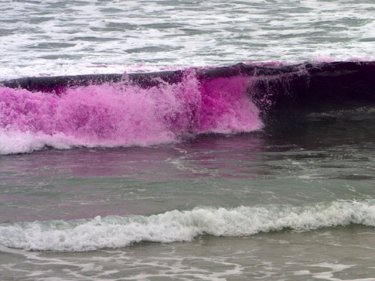PHUKET: Safety in the water celebrated a purple patch at Karon yesterday. Dr Rip's demonstration left everyone who saw it in no doubt that Phuket authorities should be doing more to save needless drownings.
It was a simple experiment. Dr Rip - otherwise known as Associate Professor Dr Rob Brander of the School of Biological, Earth and Environmental Sciences at Sydney's University of New South Wales - dropped purple dye into the sea at two spots at Karon beach.
Before long, the two bucketloads of dye met and streamed out from the beach, trapped in a rip current just the way any unwary swimmer could be.
Lifeguard managers, water safety experts, the media and passing holidaymakers turned out to see the fascinating experiment. If local Phuket authorities turned up, we failed to spot them.
But then, saving tourists' lives does not seem to be one of their priorities. Perhaps there was a resort staffer among the audience. Perhaps not.
From a rickety lifeguard tower in need of replacement, we could see along the beach to where the lifeguards' red and yellow flags defined the safe swimming area.
There were several tourists in the water. But we didn't see any swimming between the flags.
Only a concerted campaign combining the local authorities, the lifeguards and all resorts can give Phuket a thorough, cooperative approach to saving lives at the beaches and at day-trip snorkelling destinations.
Dr Rip said the aim of his demo in showing people how a rip works is to encourage holidaymakers to swim between the flags, and to not swim when it's clearly unsafe in the water.
One of these days, perhaps, Phuket authorities will understand the importance of the message to the future of the island as a year-round beach destination.
Dangerous rips usually form in the part of the sea shore that appears flattest and safest.
Dr Rip's YouTube video that explains how to identify a rip has had more than 1.2 million views so far.
How to Survive Beach Rip Currents
http://www.youtube.com/watch?v=-hCZuYzNujI
It was a simple experiment. Dr Rip - otherwise known as Associate Professor Dr Rob Brander of the School of Biological, Earth and Environmental Sciences at Sydney's University of New South Wales - dropped purple dye into the sea at two spots at Karon beach.
Before long, the two bucketloads of dye met and streamed out from the beach, trapped in a rip current just the way any unwary swimmer could be.
Lifeguard managers, water safety experts, the media and passing holidaymakers turned out to see the fascinating experiment. If local Phuket authorities turned up, we failed to spot them.
But then, saving tourists' lives does not seem to be one of their priorities. Perhaps there was a resort staffer among the audience. Perhaps not.
From a rickety lifeguard tower in need of replacement, we could see along the beach to where the lifeguards' red and yellow flags defined the safe swimming area.
There were several tourists in the water. But we didn't see any swimming between the flags.
Only a concerted campaign combining the local authorities, the lifeguards and all resorts can give Phuket a thorough, cooperative approach to saving lives at the beaches and at day-trip snorkelling destinations.
Dr Rip said the aim of his demo in showing people how a rip works is to encourage holidaymakers to swim between the flags, and to not swim when it's clearly unsafe in the water.
One of these days, perhaps, Phuket authorities will understand the importance of the message to the future of the island as a year-round beach destination.
Dangerous rips usually form in the part of the sea shore that appears flattest and safest.
Dr Rip's YouTube video that explains how to identify a rip has had more than 1.2 million views so far.
How to Survive Beach Rip Currents
http://www.youtube.com/watch?v=-hCZuYzNujI









